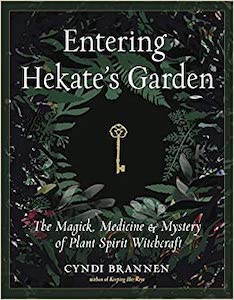
Entering Hekate’s Garden: The Magick, Medicine & Mystery of Plant Spirit Witchcraft, by Cyndi Brannen, PhD
Weiser Books, 1578637228, 288 pages, November 2020
The Garden of Hekate, the great Mother Goddess from whom all the world flows, is the spiritual home for the practice of pharmakeia, the ancient art, craft, and science of plant spirit witchcraft. This practice uses botanicals for corporeal purposes, the crafting of magical formulations, and the art of transcending. It is a holistic art transmitted by Hekate and her witches for our use today. 1
Entering Hekate’s Garden: The Magick, Medicine & Mystery of Plant Spirit Witchcraft by Cyndi Brannen is a book about plant spirit witchcraft, a craft which incorporates magick, medicine, and the mystery of botanicals through the use of both their physical properties and their spiritual essence. This book is for anyone passionate about plants and magically inclined, ready to take a deep dive into the mysteries of the spiritual essences and consciousness of plants. While more and more witches are carving out a career niche in the practice of clinical herbalism, Entering Hekate’s Garden takes it a step further and elevates the practice of working with plants into the spiritual realm by creating relationship to the soul of the plants and understanding their magical properties as well as there medicinal.
Entering Hekate’s Garden reads like a sacred text. It begins with a poetic portrait of how the dark Goddess of Nature surrendered her guard to her lover, civilization, and was betrayed. This prologue is called “Medea’s Truth.” It sets a tone that this text is a reclaiming of a lost art. That lost art is the tending of Hekate’s Garden. Medea is the darker of the two daughters of Hekate, an underworld Goddess and Queen of Witches known also as Regina Maleficarum. The other daughter is Circe. As Brannen write, “Medea’s energy and archetype speak to our shadow selves. Circe summons us to speak to embrace the transformation found by speaking our truth boldly.”2
In “Medea’s Truth,” the author channels the words of her Goddess’s despairing truth.
“Jason came to me, not out of affection, but out of greed. He had heard of my powers…Jason’s gods preyed upon his ambitions. They instructed him on how to seduce me. Not only did I welcome him into Hekate’s garden, but I put a spell on…the Tree of Knowledge…. Now the time has come for you to remember the magick, the medicine, and the mystery. Return to Mother’s Garden.”3
The book’s narrative spirals open like an actual initiation. The chapters following, each named in Latin, lay out a sacred system of working with 39 specific plant species which Brannen has selected to present – 39 being 3 x 13. Three for Mercury, God of gathering information, and 13 for the 13 moons in a Witch’s Year. Though all plants have sacred properties, according to Brennan, for the purposes of this book, which is meant to be an introduction to the way of Hekate’s Garden, 39 was a sufficient number to work with. Throughout the book, Brennan offers detailed recipes for medicines and spellwork (and for her, medicine and spellwork are one) that the reader can replicate at home for their own journey.
The book unfolds as follows:
· Origio: Meeting the three Goddesses through purification ritual instructions
· Praeparatio: A brief introduction to holistic healing and the practicing of true medicine.
· Ratio: Understanding the language of archetypes, specifically the four elements, the seven planetary correspondences, the three worlds (lower, middle, and upper), and Seven Sacred Forces (passion, strength, sovereignty, power, discipline, awareness and integrity). Plus, there is a powerful initiation ritual called the Sacred Seven Ritual.
· Practica: Physical formulations of plant medicine, such as how to tincture and make syrups and oxymels.
· Gnosis: The 39 monographs of plants used in sacred plant magic.
For each of the 39 plant monographs, from basil to foxglove to saffron to walnut, Brennan offers a bit of lore about the plant. For example, “Thyme has been associated with the bumble since Greek warriors used them both to decorate their battle gear”.4 She includes a thorough list of properties and correspondences, such as zodiac sign, stones, and animal. She also includes indications, formulations (for example, “Cats are often fond of thyme and it is safe for them”5) and a yummy recipe for goat cheese crescents.
The book concludes with Magikeia, and here reads very much like a classic grimoire with specific instructions on using plants in particular spellwork. She includes a long list of common types of spells and how to make basic formulations for them, which can be further customized as a practitioner gets more comfortable using the monographs. The list includes popular spellwork topics like abundance, binding, attraction, and protection.
In sum, this book is absolutely beautiful! It is easy the glean that Brennan is a true devotee to her path and her spirit possesses aeons of experience with her subject. The book has heart and what it offers is no less than an actual tangible portal into a magical realm, if you are willing to follow her steps and do the initiations she outlines. For a more casual fan of plants and gardens Entering Hekate’s Garden is full of fascinating and rare information about common plants – like that yarrow is one of the most powerful plants for honoring Venus! I strongly recommend this book. It will remain a treasured piece in my own book collection for years to come and I hope to see a future hardcover addition with glossy photographs of all these wonderful, magical plants!
Carter is a professional Astrologer and founder of Success in the Stars Astrology. She has her Master of Divinity (MDiv) degree from Emory University with certificates in Women in Theology and Ministry, Clinical Pastoral Counseling, Motivational Interviewing, and Compassionate Communication. Carter received the Zen Buddhist Jukai ordination from Roshi Joan Halifax at Upaya Zen Center and is a 2nd Degree Reiki practitioner.
